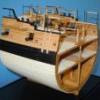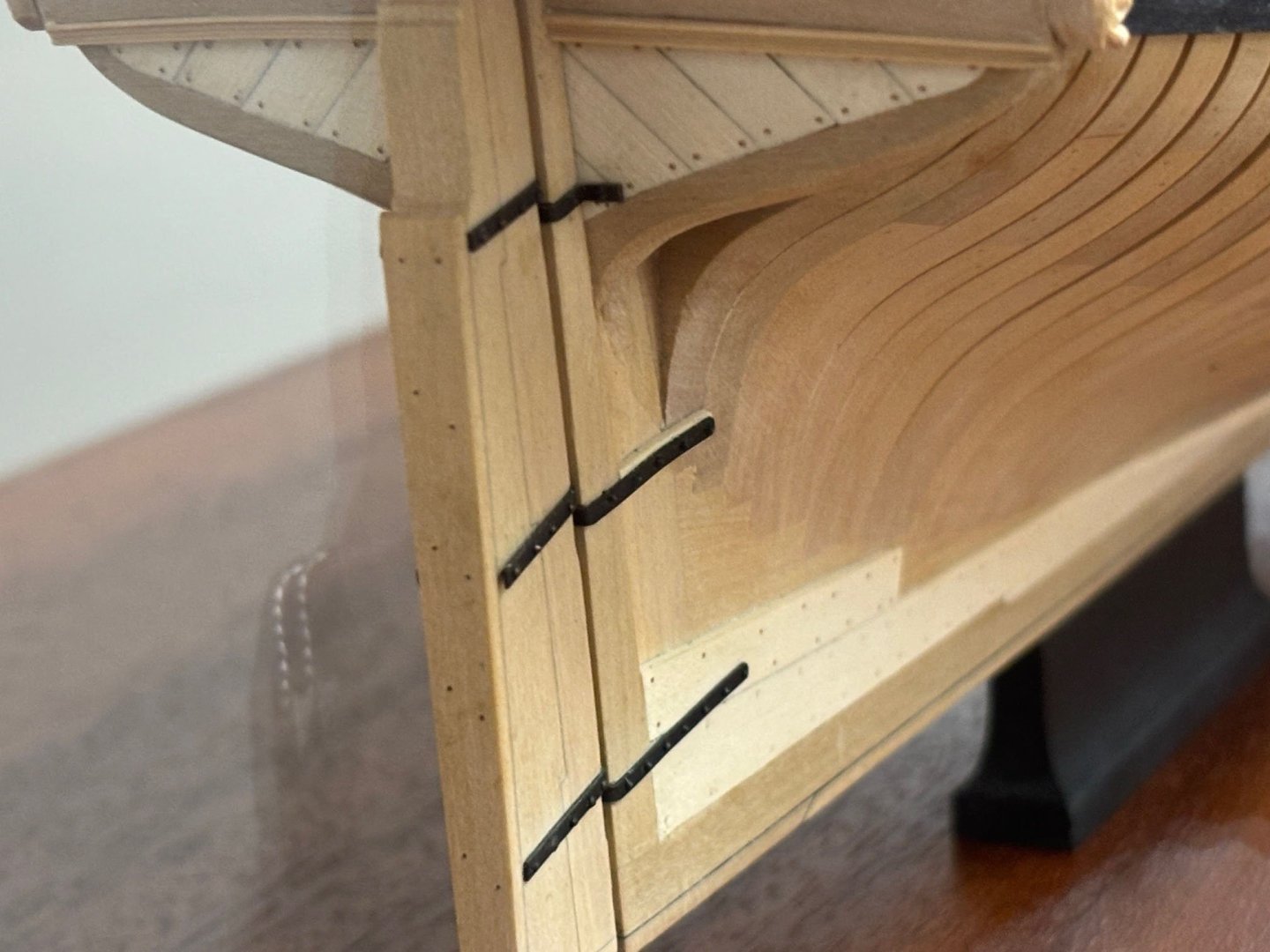-
Posts
2,457 -
Joined
-
Last visited
Content Type
Profiles
Forums
Gallery
Events
Everything posted by dvm27
-
I think those markings on the rotary table are laser engraved, Kevin. I've had my rotary table for almost twenty years and it still looks new. Have you tried contacting them for a solution? They are very responsive and once repaired my lathe for a minimal fee as well as replacing numerous old parts without charging me. As for those square holes you need to fix I could envision using your smaller mill end and making a very small second cut a half a degree away or so. You only see the outside opening so the inside shape really doesn't matter. Enjoy New York in the dead of winter. Don't you live in a tropical paradise? Are you one of those lunatics that wait in Times Square for New Years?
- 1,126 replies
-
I stand corrected Chuck. That's as neat a splice as I can make with cotton rope and PVA. Do you fray or tease the end at all before gluing? One other CA glue advantage in rigging is the speed at which you can work. A dilute PVA splice takes about 15 minutes before I'm comfortable applying pressure to it. A CA splice can be used immediately. But one advantage to a PVC knot or splice is that it can be dissolved in a bit of alcohol and the end of the rope can be reused. This is convenient if, for example, a lanyard has to be tensioned later on. I suspect a CA splice is forever?
-
Excellent discussion on using CA for wooden parts. Now let's talk about CA for rigging. I am currently rigging a commissioned model which specifies that no CA is to be used. I love the Syren rope made by Chuck but polyester ropes cannot be secured with PVA (diluted white glue) so CA must be used. Thus, on this model I am using cotton ropes from Ropes of Scale in Canada. It is also excellent rope and binds readily with PVA (although much slower). Below are some random observations on PVA vs CA in rigging based on my experience. I have a rigged model of Hannah made in the 1990's with rope splices secured by CA and no lines have broken. The joints do feel a bit brittle though. Some have a white residue but this is an early CA version. I have had no issues since switching to Bob Smith's CA medium viscosity). Faux splices can appear a bit clunky with CA. Faux PVA splices, however, are very natural in appearance and quite strong (see The Fully Framed Model, Volume 4, David Antscherl). Europeans have been using CA quite generously on their hulls and rigging for many years so, obviously, this is widely accepted practice as they have many European competitions. Some of the finest ship models are made in Europe and almost every country has their own version of Model Ship World. With auto translate you can see these masterpieces. Due to the current tariff wars the rope I am purchasing from Canada is much more expensive (35% duties). Perhaps this will change in the near future. I should also mention that Ropes of Scale also sells polyester rigging. Finally, if you Google AI on this matter the clear winner for rigging ship models is polyester. See below: " For ship models, polyester is superior for longevity over cotton due to its high resistance to fading, mildew, moisture (doesn't weaken when wet), shrinking, and abrasion, making it ideal for sails and rigging that need to hold shape and color long-term, while cotton is softer but fades, weakens when damp, and attracts mildew, though it offers a natural look. Polyester: The Durable Choice UV & Color: Excellent colorfastness; resists fading from sunlight. Moisture: Hydrophobic (doesn't absorb much water) and dries quickly, preventing rot and mildew. Strength: High tensile strength and abrasion resistance. Shape: Resists shrinking, stretching, and wrinkles. Best For: Sails, rigging, and any part needing robust, long-lasting performance, especially in damp environments. Cotton: The Natural (But Weaker) Choice UV & Color: Prone to fading and noticeable color loss over time. Moisture: Absorbs water, loses strength when wet, and can rot or mildew. Strength: Lower abrasion resistance than polyester. Shape: Can shrink and wrinkle. Best For: A more traditional, natural look where longevity isn't the top priority, or for indoor-only models. Conclusion for Ship Models Choose polyester for maximum durability and realism over decades, as it mimics sailcloth's performance in weather. Use cotton for a softer, classic look, but be prepared for potential fading, weakening, and mildew if exposed to moisture or strong light over time.
-
Rigging is like a chess match. You need to think 2 or 3 moves ahead. At full size, many of these rigging tasks are easy as humans can actually move nimbly around the rigging. At our scales, fingers are not nearly as nimble getting into these tiny spaces. On my current fully rigged three masted ship of war I am trying to pre-rig all the collars, blocks etc. that I can, but I'm sure I'll forget some. Adding sails almost doubles the amount of lines so your degree of difficulty is even higher. Some highly motivated modelers actually work out every line, its standing portion and falls before rigging in a neat little book. But that ain't me. Great job so far Jason!
-
You did a masterful job blending those two molded rails below the hance, Siggi. I'll have to look back in your log to see how you did it as there must be a joint somewhere near the volute central portion.
-
Looking good, Kevin. I also use the four jaw chuck to hold square stock. Theoretically, it should be dialed in with an indicator but I believe that's more for precision work in metal. Sometimes I need to move the part to the mill then back to the lathe. In order to get the centering correct again make a small tick mark on one of the jaws of the chuck and the wood indentation adjacent to it. That way you'll get the same centering after transferring the piece back to the lathe.
- 1,126 replies
-
Great video Kevin. You'll note that some of the eyes for the gun tackle are located within the hanging knees, both next to the ports and cast. Look at the 3D photo you've included. As I recall I fitted the deck beams temporarily then added the hanging knees. This helped locate the iron rings. You can then remove the deck beams, rig the cannons then install the deck beams permanently. Also, it's good to know I'm not the only one who has to constantly reinvent certain techniques. Fortunately, I had an extensive photo log so that has helped me remember previous techniques.
- 1,126 replies
-
Also, for some people it is all about the building process while, for others, it is about completing as many ship models as possible during our short time here. Both approaches are equally valid and everyone gets to follow whatever path they choose.
- 2,696 replies
-
- heller
- soleil royal
-
(and 9 more)
Tagged with:
-

HMS RESOLUTION 1667 by KarenM - 1:48
dvm27 replied to KarenM's topic in - Build logs for subjects built 1501 - 1750
Masterful work, Karen! We look forward to your next update. -
I can indeed confirm that Ropes of Scale is adding the tariff to their prices. But it's not Ben's fault and he has no choice but to pass on the tariff to customers. As for Chucks products I believe, like most artists, he is amazingly talented but a crappy businessman. I think we all know the value we are getting with his products. I bet things would change if his wife ran the business!
-
Congratulations, Henry, on the completion of your Swan class model. I believe you have incorporated every element included in our four volume series and, that in itself, is an amazing feat. Look forward to those final photos. Greg
- 257 replies
-
- pegasus
- Swan-class
-
(and 1 more)
Tagged with:
-
Just curious Vaddoc, but have you every tried to contact Leo? As a patron of his channel he sent me a personal thank you and, as well, very much enjoyed seeing some of my ship models. He really is as nice as he seems in his videos. If you were to inform him of your project I suspect he would find it of interest and maybe even help you with problem areas. After all, he has the real thing.
-
Congratulations on the completion of your beautiful decade-plus model. I'd venture a guess that many have started building Cutty Sark but few have finished.
- 42 replies
-
- Cutty Sark
- Sergal
-
(and 1 more)
Tagged with:
-
Looks fantastic Cisco! For forming very small eyes or squeezing those brass rings together in your jig check out https://www.lindstromtools.com/us_en/round-nose-tipped-pliers-with-synthetic-handle-pb_7590-7591_.html These tapered round nosed long tip pliers should be in every modelers workshop. You can also purchase acrylic markers which are perfect for painting nail heads and other touch ups. For example on Amazon https://www.amazon.com/Arrtx-Black-Acrylic-Paint-Pens/dp/B0BNNBLPYC/ref=sr_1_6_pp?crid=PG14ZMY19NK8&dib=eyJ2IjoiMSJ9.V6hDpXydVSevtUk2GHUhRarGzI-spNScCnP4DIbkwf40k_T46pel4IisxFZnRlsdj_yCx_QPo-uWjqC5Iz7EbMdsDmf6jEMDkiPxhzi2onEh0EknNBFMJraonquMdZKAr7pUjwD9BP_ZJYLcP6-EeDqENkcXA8QMjujhorxzYonrSZBWg_CvORqGzmv-tZ5H2-VO_9zWL_8IDXt52jlDqSyroXzkHPOtXRRvEenVrygCy47Vitid2GL8id9oIFcBWxm29mXSPxeAGGkhsciY6bQ32oS3_NuSuAPkzI5ando.df48nI2iAEzWBf8AWD5nW8tP6orYYf_xnEs_vUwuAbg&dib_tag=se&keywords=acrylic%2Bpaint%2Bmarkers&qid=1758409515&sprefix=acrylic%2Caps%2C114&sr=8-6&th=1
- 23 replies
-
- Speedwell
- battle station
-
(and 1 more)
Tagged with:
-

Mara thread - what colors do you use for fabricating ropes
dvm27 replied to Sterling59's topic in Masting, rigging and sails
In French Navy Board ship models I've noted that approach as well Chuck. I actually like the way it looks. According to M. Delacroix, the noted French naval scholar: "In the French Navy, all ropes are tarred, whether standing or running. This color is reddish-brown. The color then changes with use: - The color of the standing rigging dont change and even tends to darken with the successive layers of tar it periodically receives, turning a dark brown close to black. - The color of the running rigging does exactly the opposite; the ropes lighten as they pass through the blocks, as they rub against other elements in the mast, and of course at the mooring points. The color of these ropes then becomes slightly lighter, towards a light brown. The vast majority of models in French museums were re-rigged by people with limited knowledge. It is therefore not surprising to find beige ropes in museums." -
Welcome aboard Willi. It's rare to see a museum quality model such as your Swedish yacht actually under sail. Well done!
About us
Modelshipworld - Advancing Ship Modeling through Research
SSL Secured
Your security is important for us so this Website is SSL-Secured
NRG Mailing Address
Nautical Research Guild
237 South Lincoln Street
Westmont IL, 60559-1917
Model Ship World ® and the MSW logo are Registered Trademarks, and belong to the Nautical Research Guild (United States Patent and Trademark Office: No. 6,929,264 & No. 6,929,274, registered Dec. 20, 2022)
Helpful Links
About the NRG
If you enjoy building ship models that are historically accurate as well as beautiful, then The Nautical Research Guild (NRG) is just right for you.
The Guild is a non-profit educational organization whose mission is to “Advance Ship Modeling Through Research”. We provide support to our members in their efforts to raise the quality of their model ships.
The Nautical Research Guild has published our world-renowned quarterly magazine, The Nautical Research Journal, since 1955. The pages of the Journal are full of articles by accomplished ship modelers who show you how they create those exquisite details on their models, and by maritime historians who show you the correct details to build. The Journal is available in both print and digital editions. Go to the NRG web site (www.thenrg.org) to download a complimentary digital copy of the Journal. The NRG also publishes plan sets, books and compilations of back issues of the Journal and the former Ships in Scale and Model Ship Builder magazines.





